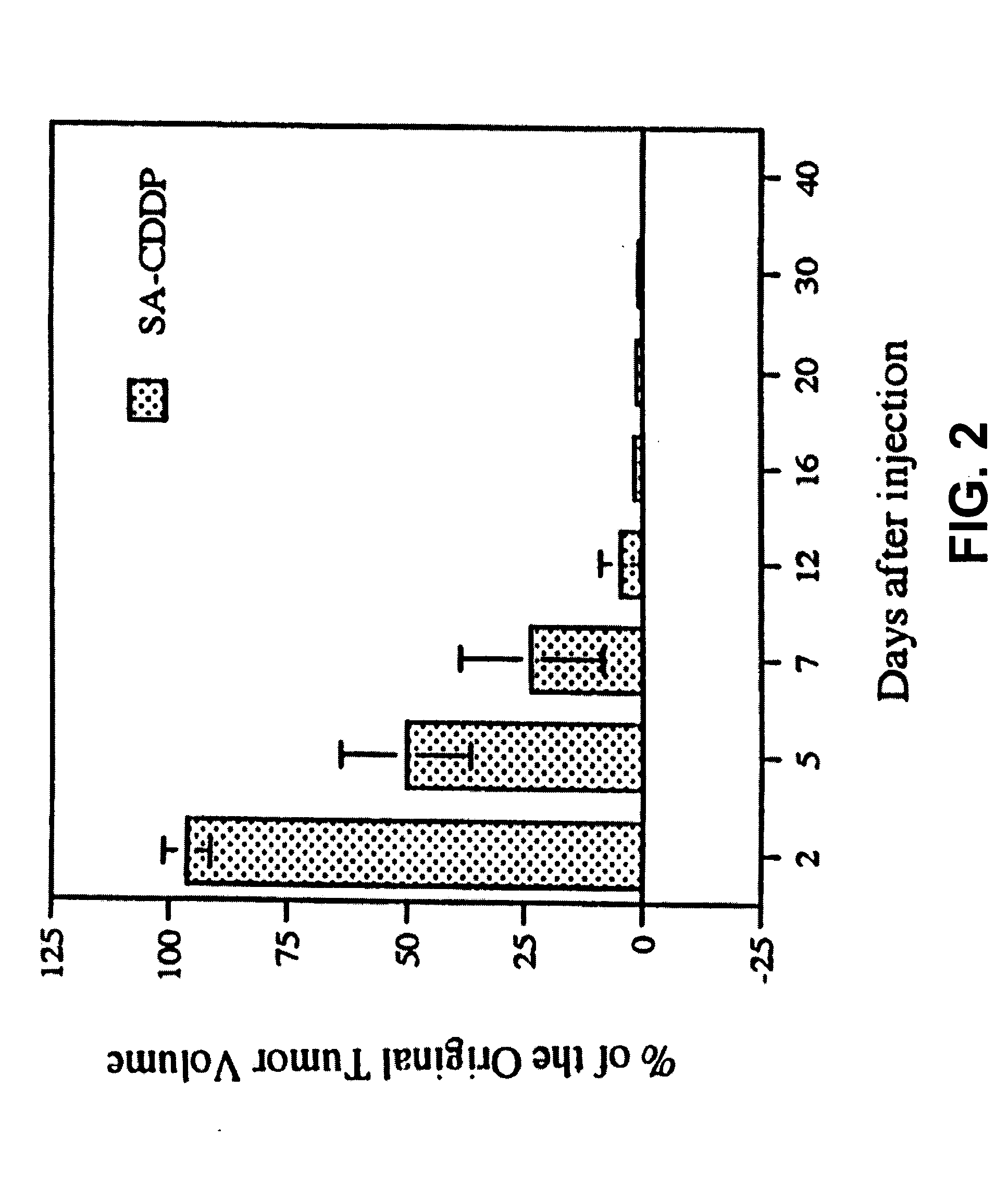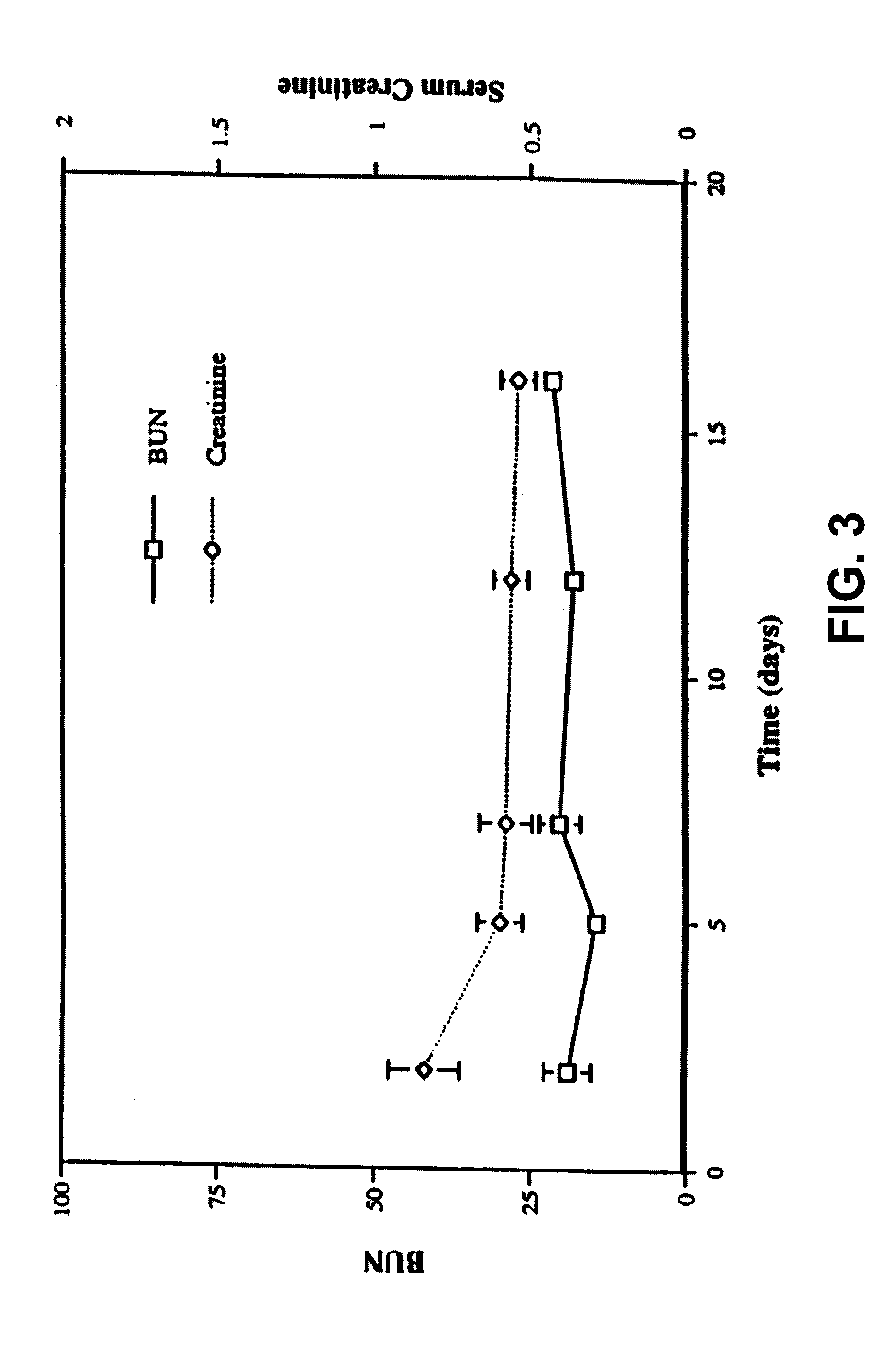[0032] In an additional embodiment of the present invention, there is a kit for treating a tumor in situ in an individual comprising, in a suitable containing means a first container having a polymer composition; and a second container having a cross-linking composition. In a specific embodiment, the polymer composition further comprises a therapeutic agent. In another specific embodiment, the polymer is a polysaccharide, a polyamino acid polymer, or a combination thereof. In an additional specific embodiment, the polymer is a polysaccharide, and the polysaccharide polymer is alginate, hydroxycellulose, chondroitin, chitosan, or hyaluronate. In an additional specific embodiment, the polymer is a polyamino acid polymer, and the polyamino acid polymer is polyglutamate or polyaspartate. In an additional specific embodiment, the cross-linking agent is a salt of a divalent cation. In a specific embodiment, the divalent cation is Ca2+, Mg2+, Mn2+, Cu2+, Cr2+, Sr2+, Zn2+, Ra2+, or Be2+. In another specific embodiment the salt of a divalent cation is calcium chloride, calcium sulfate, calcium phosphate, calcium carbonate, calcium chlorate, calcium fluoride, calcium bromide, magnesium chloride, magnesium sulfate, magnesium phosphate, magnesium carbonate, magnesium chlorate, magnesium fluoride, magnesium bromide, manganese chloride, manganese sulfate, manganese phosphate, manganese carbonate, manganese chlorate, manganese fluoride, manganese bromide, copper chloride, copper sulfate, copper phosphate, copper carbonate, copper chlorate, copper fluoride, copper bromide, chromium chloride, chromium sulfate, chromium phosphate, chromium carbonate, chromium chlorate, chromium fluoride, chromium bromide, strontium chloride, strontium sulfate, strontium phosphate, strontium carbonate, strontium chlorate, strontium fluoride, strontium bromide, zinc chloride, zinc sulfate, zinc phosphate, zinc carbonate, zinc chlorate, zinc fluoride, zinc bromide, radium chloride, radium sulfate, radium phosphate, radium carbonate, radium chlorate, radium fluoride, radium bromide, beryllium chloride, beryllium sulfate, beryllium phosphate, beryllium carbonate, beryllium chlorate, beryllium fluoride, or beryllium bromide. In an additional specific embodiment, the therapeutic agent is an anticancer drug, a hormone, a gene therapy composition, a radionuclide, a nutriceutical, or a combination thereof. In an additional specific embodiment, the therapeutic agent is an anticancer drug, and the anticancer drug is cisplatin, doxorubicin, Taxol, daunorubicin, mitomycin, actinomycin D, bleomycin, VP16, tumor necrosis factor, vincristine, vinblastine, carmustine, melphalan, cyclophosphamide, chlorambucil, bisulfan, lomustine, or a combination thereof. In an additional specific embodiment, the therapeutic agent is a radionuclide, and the radionuclide is 188Re, 166Ho, 213Bi, 211At, or a combination thereof. In another specific embodiment, the therapeutic agent is a gene therapy composition, and the gene therapy composition is a vector containing p53, thymidine kinase, cytosine deaminase, oxidoreductase, thymidine kinase thymidilate kinase, deoxycytidine kinase, ras; myc, raf, erb, src, fms, jun, trk, ret, gsp, hst, bcl abl, Rb, CFTR, p16, p21, p27, p57, p73, C-CAM, APC, CTS-1, zac1, scFV ras, DCC, NF-1, NF-2, WT-1, MEN-I, MEN-II, BRCA1, VHL, MMAC1, FCC, MCC, BRCA2, IL-1, IL-2, IL-3, IL-4, IL-5, IL-6, IL-7, IL-8, IL-9, IL-10, IL-11 IL-12, GM-CSF, G-CSF, and a combination thereof. In an additional specific embodiment, the vector is a plasmid, an adenoviral vector, an adeno-associated viral vector, a retroviral vector, a liposome, or a combination thereof. In another specific embodiment, the therapeutic agent is a hormone, and the hormone is luteinizing hormone releasing hormone, growth hormone, growth hormone releasing hormone, estrogen, progesterone, testosterone, androgen, corticotropin, prolactin, gonadotropin, somatotropin, somatostatin, somatotropin releasing hormone, gonadotropin releasing hormone, corticotropin releasing hormone, prolactin releasing hormone, pro-opiomelanocortin, melanotropin, calcitonin, gastrin, secretin, aldosterone, epinephrine, norepinephrine, follicle stimulating hormone, insulin, acetylcholine, aldosterone, angiotensin II, arginine vasopressin, bombesin, bradykinin, caerulein, calcitonin, cholecystokinin, chymodenin, corticosterone, cortisol, cortisone, dihydrotestosterone, dopamine, β-endorphin, epidermal growth factor, erythropoietin, estradiol, fibroblast growth factor, gamma aminobutyric acid, gastric inhibitory peptide, gastrin, glucagon, histamine, human chorionic gonadotropin, human placental lactogen, inhibin, insulinlike growth factor I, insulinlike growth factor II, leucine enkephalin, leukotrienes, lysine vasopressin, lysylbradykinin, melanin concentrating hormone, α-melanocyte stimulating hormone, mesotocin, methionin enkephalin, motilin, MSH release inhibiting factor, Mullerian regression factor, nerve growth factor, neurotensin, oxytocin, pancreatic polypeptide, parathormone, platelet-derived growth factor, prolactin inhibiting factor, prostacyclin I2, prostaglandin E2, prostaglandin F2a, relaxin, serotonin, serum thymic factor, substance P, thromboxane A2, thymopoietin, thymosina, thyrotopin (thyroid stimulating hormone; TSH), thyrotropin releasing hormone, thyroxine, triiodothyronine, urogastrone, vasoactive intestinal peptide, vasotocin, vitamin D3, or a combination thereof. In another specific embodiment, the therapeutic agent is a radionuclide, and the radionuclide is 188Re, 213Bi, 166Ho, 211At, or a combination thereof. In an additional specific embodiment, the therapeutic agent is a nutriceutical, and the nutriceutical is arabinogalactan, acerola cherry, agnus castus (vitex), amla, andrographis, artichoke (globe), ashwagandha, astragalus, bacopa, beta 1,3 glucans, beta sitosterol, bilberry, borage oil, boswellia, broccoli cruciferous, bromelain, butcher's broom, calcium hydroxyl apatite, cascara sagrada, cat's claw, cetyl myristoleate, chamomile, chitosan, chlorella, chondroitin sulfate, chromium yeast, citrus aurantium, citrus seed extract, co-enzyme Q10, colostrum, cordyceps, cranberry, creatine monohydrate, devil's claw, DHEA, DMG, dong quai, Echinacea, elderberry, ephedra, evening primrose oil, feverfew, fish marine lipids, fish oil concentrate powder, fish protein powder, flaxseed oil, garcinia HCA, garlic T.A.P., germanium Ge-132, ginger, ginkgo, ginseng-American, ginseng-Siberian, ginseng-Asian, glucosamine, goldenseal, gotu kola, grapeseed extract, green tea extract, guarana, gymnema, hawthorne, hops, horse chestnut, horsetail, kava kava, kola nut, lecithin, licorice, lipoic acid, lycopene, medium chain tri-glycerides, melatonin, milk thistle, MSM, muira puama, nag, nettles, noni, ocimum sanctum, octacosonol, olivir, passion flower, pau d'arcophosphatidylserine, picrorhiza, potassium glycero phosphate, pygeum, quercetin, reishi, saw palmetto, schisandra, sea cucumber, selenium yeast bound, shark cartilage, shark liver oil, shiitake, shilajit, sodium copper chlorophyllin, spirulina, squalene, St. John's Wort, stevia, suma, tribulus (Bulgarian) triphala, tumeric, uva ursi, valerian, wild yam extract, willow bark, or yohimbe bark extract. In another specific embodiment, the therapeutic agent further comprises a detectable identifier, and the detectable identifier is an X-ray contrasting agent, a CT contrasting agent, an MRI contrasting agent, a fluorophore, or a luminophore.
[0033]
 Login to View More
Login to View More 


